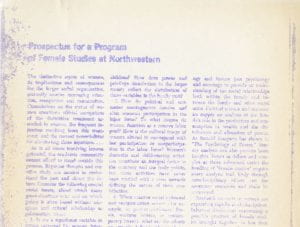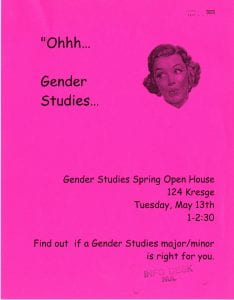As we begin to see the light at the end of the first-quarter tunnel, and to prepare for Winter Quarter classes, let’s take a moment or two to reflect on the Northwestern Board of Trustees’ 1869 promise to offer education to women “on the same terms” as men — and how this played out in women’s academic choices over the years.
In the beginning, the promise was was easily realized. All courses and programs on the Evanston campus were open to women, and men and women students had to follow the same curricula and meet the same degree requirements to receive a Bachelor’s degree.
But after 1900, due to national social and educational trends, the “same terms” become harder to define. Throughout collgiate education, concepts of curricula became more flexible and much broader in scope. As Northwestern grew larger, it added new options for specialization, such as electives and majors — as well as “professional schools.” Meanwhile, societal trends (the Depression, World Wars, the women’s movement) also affected the choices students made. As a result, although in most cases no restrictions were set on who could take what courses (at the undergraduate level), men and women began to follow divergent paths in their coursework: men dominated engineering programs while women were more likely to pursue education, music, and speech.
Two additions to Northwestern’s curriculum — home economics in 1943 and women’s studies in 1980 — showcase drastically contrasting moments in this evolution. Further, a look at women and STEM reveals how things continue to change as women students ar Northwestern have interpreted the promise of “the same terms.”
Home Economics, 1943
Although the concept of offering courses for women in the “domestic arts” had been proposed since the early 1900s, it was not until 1943 that such a program was offered at Northwestern. The new Home Economics Department (through Weinberg College, and housed in Fisk Hall) was presented as a serious and academic program. The first announcement noted that since most women marry within three years after leaving college, home economics training was “valuable for effective personal and family living.”
Home economics was remarkably interdisciplinary, inviting speakers from the medical school, psychology, biological sciences, and religion, as well as successful career women. Over the years, the curriculum changed to include “The Development and Actualization of the Self” and “Public Policy and the American Family.” But by the 1970s enrollment had dwindled to 10 students majoring and three faculty. The department was discontinued in June 1973.
“A Community of Scholars,” 1968-9
In 1968-69, in the face of societal changes and student protests, an all-male task force produced the transformational “Community of Scholars” guidelines suggesting new approaches to undergraduate education: changes in curriculum, in residential life, in faculty-student interactions. The 200+ page report addressed the need for interdisciplinarity, more programming in what we now call STEM, and awareness of globalism and minorities. But it did not once mention women or the need to include them in programs such as the sciences where they had not been present, or to incorporate courses relating to gender.
Women’s Studies, 1980
An ad-hoc committee of women faculty and grad students formed in 1969 (it would become the Organization of Women Faculty in 1981), and a Women’s Studies Residential College was established in Allison Hall in 1976. But it was not until 1980 that women’s studies entered the academic curriculum as a certificate program in Weinberg, coordinated by the Program on Women. It offered three courses. Like home economics, the early women’s studies program was interdisciplinary, recommending related courses in philosophy, sociology history, and literature.
In 1991, the University made its first faculty appointments in the program; in 1992, Women ’s Studies awarded its first graduate certificate; and in 1993, the program became a department, offering a major in Women’s Studies. The department was renamed Gender Studies in 2000, and Gender and Sexuality Studies in 2012.
STEM, 1970s-90s
Women’s increasing interest in STEM is reflected in the Technological Institute (McCormick School)’s slowly growing numbers of women in the various fields of engineering. In 1970, of the 786 undergraduates enrolled in Tech, 31 were women (from 1966-70 an average of nine freshman women enrolled each year). By 1980, 25 percent of the undergraduates in Tech were women, going up to 31% in 1990. Other STEM fields followed—in 1986, 0.7 percent of entering first-year women were considering a major in Mathematics/Statistics, compared with 2 percent of first-year men, but ten years later the numbers were almost even (1.3 percent and 1.4 percent).

Engineering classes circa the 1950s, left, and the 1980s, when the gender distribution had changed considerably.
Avenues for Research
Records in University Archives can answer straightforward questions about how many women enrolled in Northwestern history and in what fields they got their degrees. But larger questions will require much more research: To what extent were women encouraged to major in, for example, engineering as opposed to English literature? How much were their decisions influenced by societal expectations or internal University pressures? Northwestern University archivists can help researchers find the documents that dive deeper into these queries, and many more. (A future blog post will look further into the story of women in Northwestern’s professional schools.)
This blog post is based upon text and images from the Library exhibit “On the Same Terms: 150 Years of Women at Northwestern,” (running until June 2020 in Deering Library) and the accompanying catalog, “On the Same Terms: The Beginnings of Women’s Education at Northwestern.” Unless otherwise noted, all documents and images featured are drawn from collections in the University Archives.
This fall marks 150 years since women could enroll as Northwestern undergraduate students. As the University collectively commemorates this milestone — and the women/womxn who have shaped Northwestern — the Northwestern community will have many opportunities to reflect, be inspired and learn from each other. Throughout the academic year, events and programming will be held across the entire University and around the world. Visit the 150 years of women website (https://www.northwestern.edu/150-years-of-women/) to learn more and get involved.







